I ate a famed Filipino dish made with pig brain and spine for just 25 cents, and it was the perfect savory snack

- Tuslob buwa is a dish made of offcuts like pig brain and spinal cord.
- Cecilia Rondino has been cooking and selling tuslob buwa in Pasil, Philippines, for over 60 years.
Pasil, a neighborhood in the Philippines, is home to some unusual dishes.

I was born to Filipino parents, so homemade Filipino food has always been a staple. Pork was often the go-to meat, and the parts used at dinnertime extended beyond ribs, shoulder, or belly. Pig ear and tongue are actually both ingredients in my family's sisig recipe — a sizzling dish made with chopped pork parts, served with a spicy and sour sauce. But there are parts — including the pig's brain — that I had never considered trying.
Before traveling to Cebu for a reporting trip, I had heard from several locals about a popular Pasil dish called "tuslob buwa," a gravy that uses pig brain as its star ingredient.
Pasil is a neighborhood in Cebu, an island-province in central Philippines. It's one of the culinary centers of the province, thanks to its abundance of seafood. Less common fish — including shark, puffer, and stingray — are used in local dishes.
But like most other parts of the Philippines, pig meat — including offcuts — is used widely in the province's cuisine. Offcuts are pieces of meat that are often discarded, including the cheek, tongue, and even brain.
Curious about the taste, I decided to spend a day at a local food stall famous for tuslob buwa and sample the dish for myself.
I met Cecilia Rondino, who has been cooking and selling tuslob buwa for over 60 years.
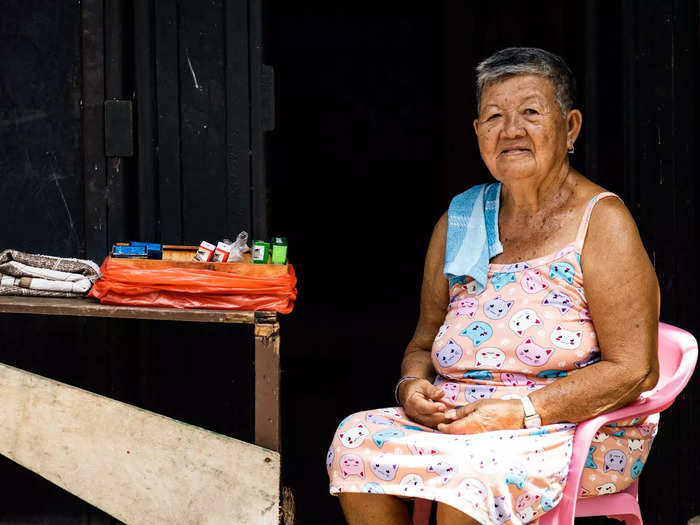
One of my guides in Cebu, Dodong, introduced me to Rondino, whom he said was one of the first vendors of tuslob buwa in Pasil.
I met Rondino on a weekday in Pasil. It was past lunchtime, so the streets were quiet and empty, with only a handful of people relaxing on the side of the road. It was hot and humid, and the smell of deep-fried dishes from the karinderya — a Filipino-style restaurant serving local delicacies — nearby permeated the air.
Rondino, a 78-year-old Pasil resident, told me she's been selling tuslob buwa — a gravy made with pig offcuts and typically eaten with steamed rice — since the 1960s. That afternoon, she was sitting on a pink plastic chair right outside her house, displaying packs of cigarettes and newspapers for sale on a wooden table. Her stall, where she sells her specialty dish, was parked by the street a few steps away. On that day, her 31-year-old daughter Maria was helping run the stall.
Maria had a different character from her mother. While Rondino was bright and cheerful, Maria was more reserved, busy making the dish in a small, colorful cart draped with a piece of purple cloth decorated with a Minnie Mouse print.
Rondino explained that her version of tuslob buwa is different from what is commonly served in the neighborhood. Rather than using pig brain, the more popular choice, she uses the pig's spinal cord.
"It started in the markets, and then we experimented and tested out different parts, and found that pig spine is the best," she said in Cebuano, the local language.
Rondino's signature dish only costs 15 Philippine pesos, or 25 cents.

Rondino told me that costs for the ingredients used in tuslob buwa have drastically gone up over the years. The primary ingredient — pig spine — now costs 200 pesos, or $3.50, per kilogram. When she first started cooking the dish, it cost only five pesos per kilogram.
"I buy the spinal cord from the market. When the pork is being chopped, that's where I get the offcuts," she said. In the Philippines, offcuts can be found in most markets, where they're often bought by cooks who turn them into delicious meals.
But in the US, offcuts like spinal cord are strictly regulated. According to the US Department of Agriculture, the spinal cord isn't allowed to be sold in meat products.
"Since spinal cord tissue falls outside the definition of 'meat,' products produced using Advanced Meat Recovery systems cannot contain spinal cord tissue," the USDA writes on its website.
Rondino buys "hanging rice" from a local seller right across the street.
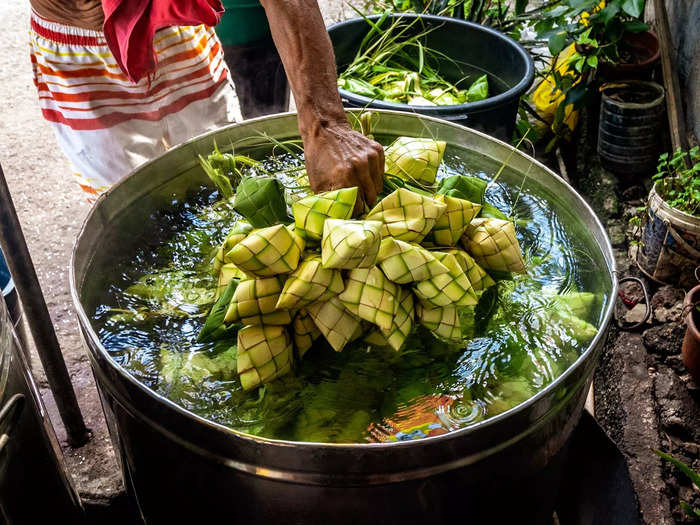
Rondino said she purchases the rice that's eaten with tuslob buwa from another vendor in the neighborhood, whose shop is just a few steps away from her stall. She buys several pounds of the freshly-cooked rice every day, depending on how many customers she expects to feed.
Like with most Asian cuisines, rice is eaten with nearly everything — and tuslob buwa was no exception. The Philippines is the eighth-largest producer of rice in the world, cultivating an average of 12.17 tonnes of rice each year. Needless to say, it's one of the most important foods in the country.
Hanging rice, locally known as "puso" is made by placing rice grains into a pouch made from palm leaves. It's then boiled in a large, deep pot of water, turning it into a rice cake. In Pasil, these are still made by hand, and often prepared right outside people's homes.
Rondino has spent decades perfecting her recipe.
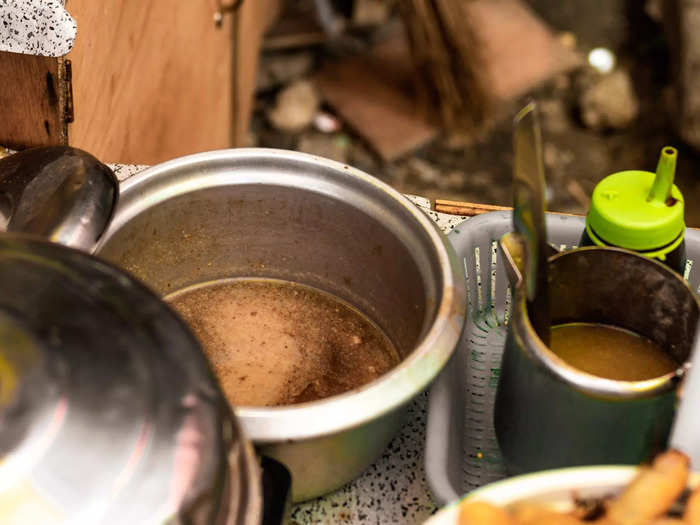
In the Philippines, food is often cooked by feeling and estimating the right amount of ingredients, rather than by using exact measurements. This also rings true when it comes to Rondino's dish.
"Nobody really taught me how to make the recipe. I just used my experience to make the recipe that's sold today," Rondino said.
The dish's raw ingredients, like pig liver, and the mashed spinal cord had already been prepared beforehand and placed in a small, metal container, ready to be cooked on the spot.
The dish was cooked for a minute on high heat — and the aroma was heavenly.
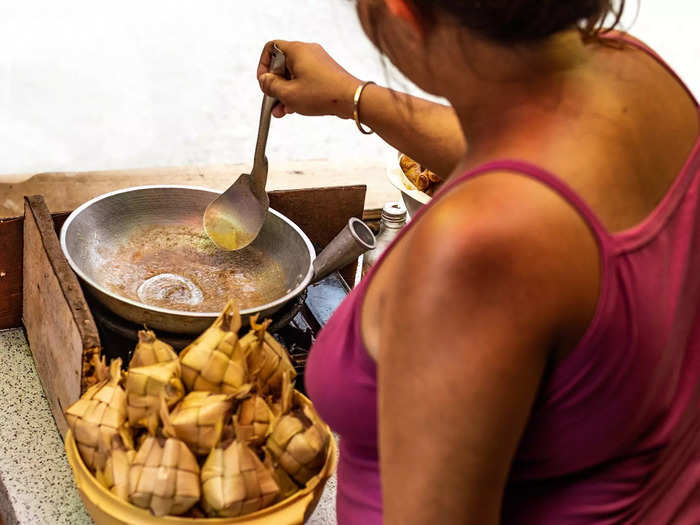
Several students from a nearby school were heartily munching on a few pieces of hanging rice. A few of them were in school uniforms. One of them told me they ate at Rondino's stall often, stopping by for an afterschool snack before heading home.
Apart from the students. Rondino told me that she has another set of clientele — nuns — whom she cooks a special batch of her dish for.
"I cook it with fried garlic and other ingredients. I make it even more flavorful for them as they're my longtime customers," she said.
Maria first poured a splash of oil into a pan, before adding a few spoonfuls of spinal cord. To add more flavor to the dish, some fish sauce was added. Finally, the prepared broth made from different parts of the pig was mixed in to complete the recipe.
The dish smelled delicious, with the aroma of sizzling gravy wafting through the street. I took a seat in front of the cart and tore off a piece of rice cake.
I discovered that sharing the dish with friends in a communal style was best.
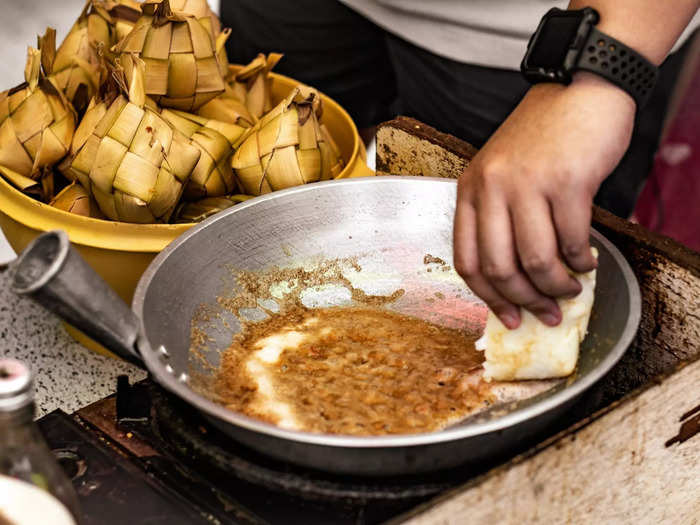
After a minute or two, Maria invited me to dip my hanging rice into the pan. The gravy was hot and still bubbling, but she assured me that it was exactly the right temperature to eat the dish. It was savory, with a strong, salty, and umami flavor. The spinal cord tasted like pork pate — a spread made with liver and spices — and I imagined it would also pair perfectly with some crunchy, toasted bread.
After I'd had a few bites, I invited two of my guides, Dodong and Nash, to join me in eating the dish. I felt it was a dish meant to be shared with others, over a conversation and a bottle of soda.
While offcuts are discarded by many, here, it's a prized ingredient responsible for transforming an affordable cut of meat into a prized delicacy that's worth trying. And for Rondino, it's become her legacy — she hopes Maria will also pass the trade down to her granddaughter.
"It's our livelihood, it provides for us," she said.
Popular Right Now
Advertisement